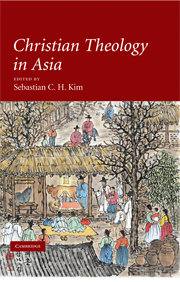Book contents
- Frontmatter
- Contents
- Contributors
- Preface and Acknowledgements
- 1 FORMATION OF CHRISTIAN THEOLOGIES IN ASIA
- 1 Introduction: mapping Asian Christianity in the context of world Christianity
- 2 The Mystery of God in and through Hinduism
- 3 Waters of life and Indian cups: Protestant attempts at theologizing in India
- 4 From abandonment to blessing: the theological presence of Christianity in Indonesia
- 5 Studying Christianity and doing theology extra ecclesiam in China
- 6 Christian theology under feudalism, nationalism and democracy in Japan
- 7 The Word and the Spirit: overcoming poverty, injustice and division in Korea
- II THEOLOGICAL THEMES OF CHRISTIANITY IN ASIA
- Index
- References
4 - From abandonment to blessing: the theological presence of Christianity in Indonesia
Published online by Cambridge University Press: 05 June 2012
- Frontmatter
- Contents
- Contributors
- Preface and Acknowledgements
- 1 FORMATION OF CHRISTIAN THEOLOGIES IN ASIA
- 1 Introduction: mapping Asian Christianity in the context of world Christianity
- 2 The Mystery of God in and through Hinduism
- 3 Waters of life and Indian cups: Protestant attempts at theologizing in India
- 4 From abandonment to blessing: the theological presence of Christianity in Indonesia
- 5 Studying Christianity and doing theology extra ecclesiam in China
- 6 Christian theology under feudalism, nationalism and democracy in Japan
- 7 The Word and the Spirit: overcoming poverty, injustice and division in Korea
- II THEOLOGICAL THEMES OF CHRISTIANITY IN ASIA
- Index
- References
Summary
Christianity in Indonesia has gone through a history parallel only to the history of the nation-state itself. As a nation-state made of diverse ethnic groups of old societies and still struggling with its pluralistic identity, Christianity in Indonesia struggles likewise. However, during the short history of the nation state, Christianity has made practical contributions to the creation of a just and egalitarian nation-state. It has been, therefore, the struggle and the call of Christianity to define its role as a blessing to the nation-state theologically.
When Christianity first appeared in the archipelago, the country did not exist yet. The people of the archipelago did not think that they would be united in the future as a nation-state. Smaller kingdoms existed in the archipelago autonomously; the two main kingdoms were Sri Vijaya, a Hindu kingdom in Sumatera from the seventh to the fourteenth century ce, and a Buddhist kingdom called Majapahit in east Java from the thirteenth to the sixteenth century ce. However, a stronger notion of Indonesia as a nation in the twentieth century ce was possible because of the legacy of western colonialism; similarly, western colonialism rooted Christianity in Indonesian society.
CHRISTIANITY: PRE-WESTERN COLONIALISM
The history of Christianity in Indonesia has been associated with western colonialism; however, based upon the history of the Catholic Church in Indonesia, Christianity appeared in the archipelago about the middle of the seventh century ce, especially in Sumatra and Java, where western nations had not appeared in the archipelago.
- Type
- Chapter
- Information
- Christian Theology in Asia , pp. 71 - 88Publisher: Cambridge University PressPrint publication year: 2008
References
- 1
- Cited by



